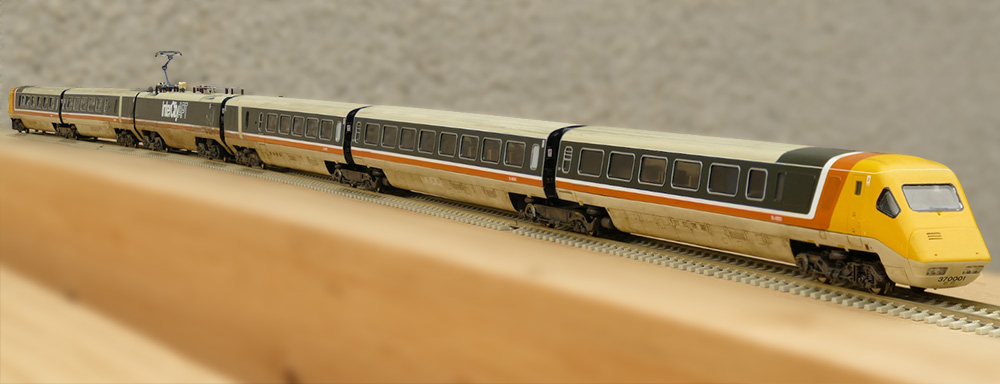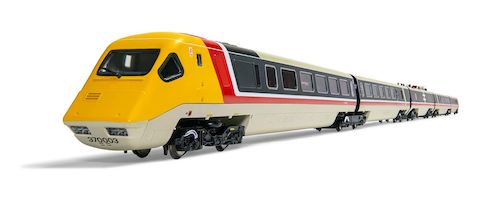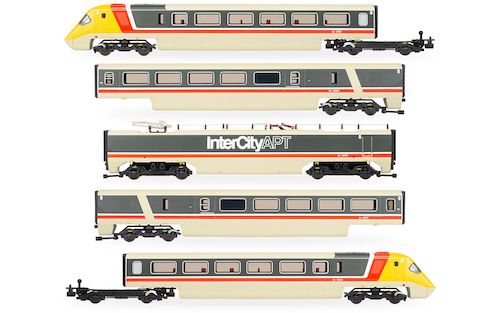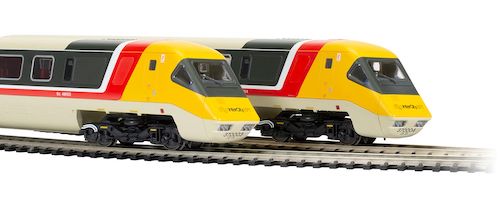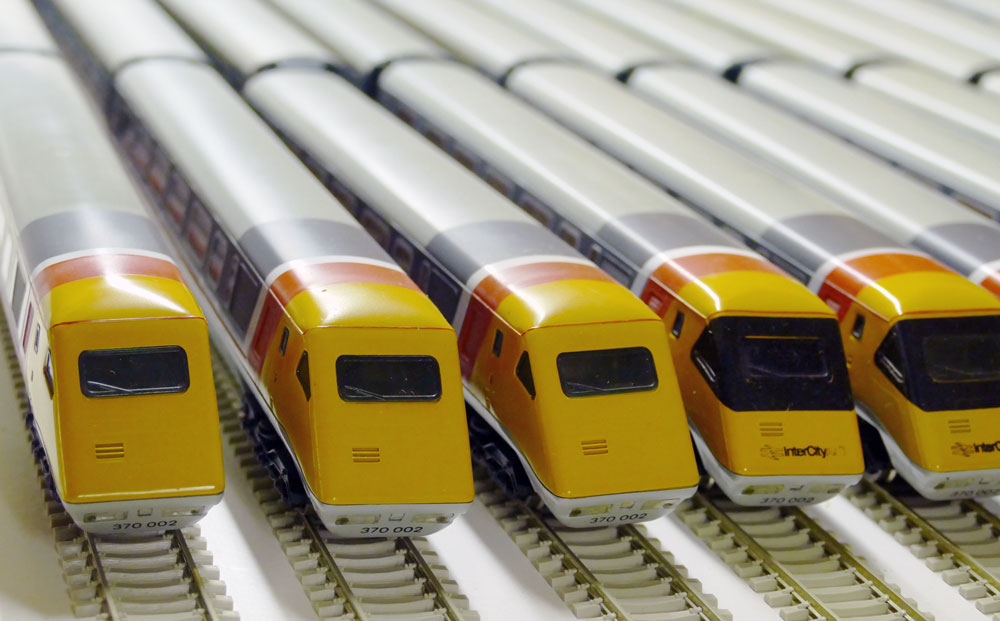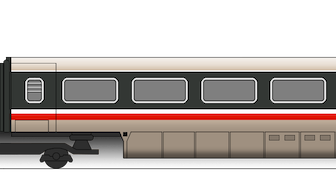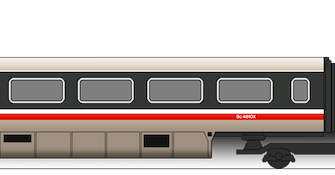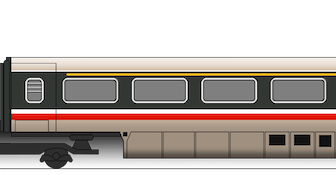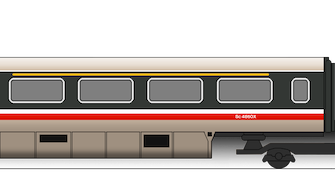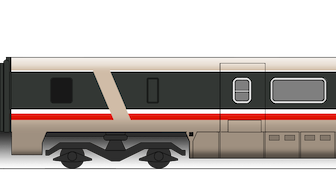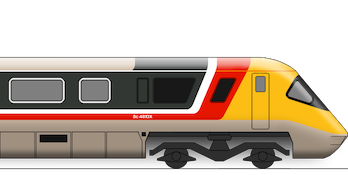While black masks were progressively applied to the APT fleet from 1980, this model most accurately recreates the fleet's appearance from about 1982 onwards. More specifically, taken together, the vehicles provided in the box are specific to Spring 1984 onwards.
This set is understood to have been intended as product aimed primarily at collectors who might display the unit rather than run/expand it. As a result, fewer trailers were manufactured, and thus these are now much harder to come by than those released to match the full yellow end version. In the event, most modellers wanted the unit with black window surrounds, as it was the most common, longest-lived colour scheme for the class.
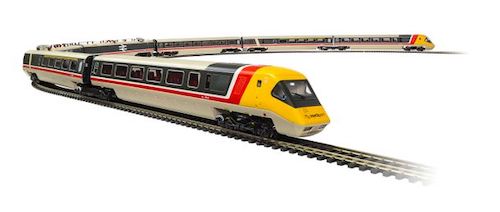
To match the set, again a full complement of intermediate trailers has been issued, this time fully lined out with first class and buffet stripes above the windows. Again the vehicles are all numbered to match the units, i.e. ending in 01 and 02. Of these only the TS from 370002 is prototypically correct, with the remainder of the trailers having a range of last numbers.
370001 & 370002 (2020 model) - what's in the box?
This model includes all the necessary vehicles to make a minimum black-masked formation, plus a second dummy power car and the 1984-converted development vehicle. Assuming you want to include all seven vehicles as authentically as possible, what are your options?
370001 & 370002 - what were they really like in 1984?
1984 formation: Starting with the period best represented by the model, Hornby's miniature version is remarkably similar to the reality of late 1984. Two vehicles are incorrectly numbered - power car 49001 would need to be amended to 49005, while by 1984, 370002's TBF was 48605, not the original 48602. Otherwise the formation is prototypical, and was seen operating as late as mid-1985.
The APT Development Coach is a welcome inclusion, as it accompanied 370001 and 49005 from around March 1984 when it was converted until withdrawal from service. In reality, both TBF 48601 and power car 49005 were given modified couplings to allow 48204 to be inserted between them, and thus were the only APT vehicles that the development coach could couple directly to. The interior detailing is excellent, but it looks like Hornby have conflated the interior of 48204 with the interior of earlier test car 48206 (which ran in 370001 in full-yellow-end days). To correctly model the interior of 48204, the left hand instrument racks should be moved to the right hand end of the vehicle (as seen from the operator side), and regular second class seating installed on the left hand side. The right-hand instrument racks (with control desk) can then be used to model the TBF-adjacent end of earlier 48206, as they are an excellent representation of that vehicle's innards, for your full-yellow model of 370001!
In July 1985, this set was used for further pantograph testing, and power car 49005 was fitted with a roof-mounted observation pod with a window facing the pantograph. During this time, the set also ran without 49002 in the formation, which was the last current sighting as a pair.
Two livery modifications are required: 48601, the TBF in 370001, never received its first-class stripe above the windows, so this would need to be removed; in 1984, 48102 received a new nose cone, which did not carry the InterCity APT logo, so this would have to be painted out for full authenticity. 
Earlier formations - 1981 to 1983: An authentic formation from early 1982 can be created using five vehicles from this set. Using both DTS cars, both TBF cars, and power car 49002, this February 1982 formation can be created accurately - though as 49002 is the dummy power car in Hornby's set, some body-swapping may be in order. The power car pantograph would also need to be swapped for an original two-stage Stone Faiveley version at this date.
Prior to this, 370001 is otherwise only currently known to have operated as a two-car set with full-length 370007 in 1981 after receiving its black mask.
Later formations: After July 1985 the pair are not believed to have worked together again. 370001 (with 48204) was variously paired with 3-car 370003 and 2-car 370006, operating until January 1986 and gaining a red stripe around its nose. Meanwhile 370002 was last noted paired with 2-car 370005 in August 1985, before being withdrawn.
Additional trailer cars
Although trailers are available to make a complete 14-car rake from this model, with its black mask 370001 never ran with any intermediate trailers. 370002, however, was made up into a full-length rake in 1980, had its TBF lined out for first class, and remained as such until late 1981 when it was shortened to the minimum two cars. At present, though, there is no available photographic evidence that 370002 actually ran paired with another unit in its full-length state.
Hornby provides 48202 in its associated TS pack, but all others would require renumbering if an authentic formation was to be created.
Alternative ideas for the set - RENUMBERING!
What else could you model with this set? As a masked pair, this set could form the basis of most post-1980 APT formations, with suitable set/vehicle renumbering and appropriate intermediate trailer selection. For the first 14-car formation, from mid-1980, put 48204 to one side, remove the rain strips from the cab ends, and renumber/extend (using all the trailer car pairs available) to 370005 and 370006 (you can keep 48401 and 49002 unrenumbered, but you'll need to swap the pantographs for two-stage Stone Faiveleys):
Alternatively keep the model of 370002 intact as a two-car set and extend/renumber 370001 to 370006 to replicate the first public service in December 1981 (again swapping the pantographs).
If you are happy to renumber everything, then the set used in public service in 1984 is an option - 370007 was ironically the only APT set to be formed as a full length set from construction to scrapping, and consequently saw the bulk of passenger operation in later years. It does seem to be the case that forming 370007 as a full-length set, rather than keeping the two end vehicles as spares, was a consequence of 370001 remaining as a test-bed and fitted with test equipment. Here's a common formation from summer 1984, and you don't have to change the pantographs either:
370001 & 370002 (1984) - modelling details
When initially repainted with a black mask, 370002 did not have a rain strip under the cab windows - this was added in about 1981 prior to formation-shortening. 370001 did first appear masked with the rainstrip fitted, though uniquely it was fitted a little lower on the nose than any of the other driving cabs, thus a minor modification would be required to be accurate on the model.
As detailed on the main page, the shape and extent of the black mask varied across all seven cabs, and the mask on 370001 was particularly large. If you are seeking full authenticity, extending the mask upwards a little on 48101 is essential! 370002's mask was also larger than average, but to a smaller extent.
370001 was heavily modified internally for initial testing, and while the plan was to refit the unit for regular service, this never came about. Thus the interiors of 48101 and 48601 remained out of the ordinary through to the end of the unit's life, featuring test equipment and other modifications. 48601 was fitted with a generator and consequently had an exhaust port in the roof of the van area, as well as air intakes in place of the route-indicator windows. This was retained into the black mask period, and power was routed to test car 48204 via the gangways.



